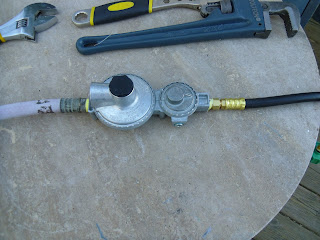I know very little about gas fitting, other than standard plumbing rules. I know that they use a different type of Teflon tape than with water. The first thing I did was remove the old regulator to make sure that I got the right one from the store. You could remove the nozzle too, but I wanted to change the style and I was not sure of the condition it either. You cannot see it here, but the O-ring is pretty rough.
I put the old hose that connects to the steel lines on the new regulator. Here you can also the new nozzle hose and some of the tools I used to get things apart and back together. I would recommend a bench vise if you have access to one.
I taped all of the connections and made sure that they were very tight. I reconnected the flex line to the steel lines. Even though they are rusty they appear to be fairly strong and intact.
Once everything was connected I cracked open the propane tank and checked all of my connections for leaks. I did not detect any leaks. It was time for phase 2 of the testing.
I went inside and ran the propane on the stove, and I think the flow is better as I did not do a control test before I removed the regulator to see the flow. When we bought the trailer there was an old propane light fixture, but the globe was damaged and I did not know what kind of mantle would go onto the light. So I removed the light fixture and put a brass nipple and elbow and then a Primus fitting (the male fitting on a disposable propane bottle, or 1" x 20 TPI Male fitting) so that I could screw my camp light onto it. When I put the light on I get a little bit of propane out of the light but there is still not enough flow to the light for it to burn. I am going to have to experiment a little to find out what is regulating the flow down so that there is not enough propane.
If you have any thoughts on this or your own propane stories, please share in the comments section.





No comments:
Post a Comment